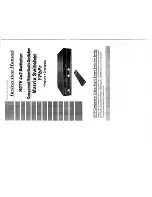
8
sensing.honeywell.com
MICRO SWITCH™ BX Series
ISSUE 17
PK 80148
ADJUSTING INSTRUCTIONS
To give flexibility in application, the user can perform the ad-
justments described below in any order before wiring the unit.
ACTUATOR HEAD
The actuator head may be positioned in any of four directions.
1. Loosen the four captive head screws.
2. Place head in the desired position.
3. Securely tighten the four screws to 1,4 Nm to 1,8 Nm [12
in-lb to 16 in-lb] (Figure 1).
REVERSING THE ROLLER LEVER
Except for the offset roller levers, the roller arm may be reversed
to face the roller to the inside or outside of the arm.
FIGURE 1.
FIGURE 2.
4 × 90°
360°
FIGURE 3.
POSITIONING LEVER
The lever on rotary actuated units is adjustable to any position
through 360° around the shaft.
1. Loosen the cap screw with 9/64-inch hexagon key wrench.
2. Move lever to desired position.
3. Securely tighten screw until teller tab can no longer be
moved by hand.
4. Tighten screw another 1/8 to 1/4 turn to assure lever is
tight on the shaft (Fig. 2).
A 9/64-inch hex key wrench is provided in the adjusting tool set
LSZ4005.
ADJUSTABLE LENGTH LEVERS
To adjust the length of the adjustable length levers, a 9/64-
inch hexagon key wrench is required. A 9/64-inch key wrench is
provided in the adjusting tool set LSZ4005.
TOP ROLLER PLUNGER
Position the top roller plunger in the desired roller plane, by
adjusting the head as explained under actuator head.
SIDE ROLLER PLUNGER
Grasp the plunger with a pair of pliers and rotate to the desired
horizontal or vertical position (Fig. 3).
CHANGING DIRECTION OF ACTUATION
SIDE ROTARY
Catalog listings with the first three letters BXA, BXH, BXL, BXP,
and BXR may be adjusted to operate clockwise, counter-clock-
wise or both. Catalog listings BXM (center neutral) and BXN
(maintained) operate in both directions but cannot be changed.
To change the actuation direction for the BXA, BXH, BXL, BXP,
and BXR, follow these steps:
1. Loosen the head screws and remove the head from the
switch housing.
2. On the bottom of the head, insert a screwdriver in the slot
provided (Fig. 4) and lift open the hinged cover.
3. Referring to Fig. 5, slide the cam all the way back, so cam is
free to rotate on the shaft.
4. Using a screwdriver or similar tool, rotate the cam to the
desired actuating position (Fig. 6).
5. Slide the cam all the way forward to its original position,
and close the hinged cover.
6. Replace the operating head on the switch housing and
securely tighten the head screws to 1,4 Nm to 1,8 Nm [12
in-lb to 16 in-lb].
FIGURE 4.
FIGURE 5.
FIGURE 6.








































